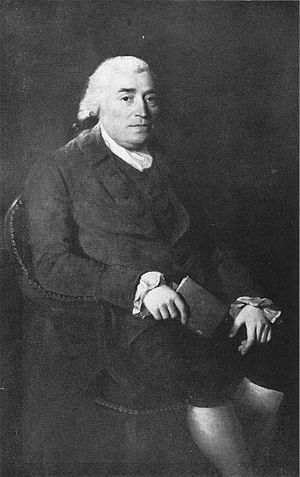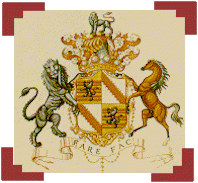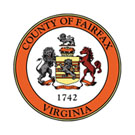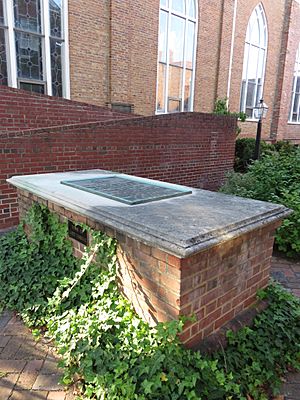Thomas Fairfax, 6th Lord Fairfax of Cameron facts for kids
Quick facts for kids
The Lord Fairfax of Cameron
|
|
|---|---|
 |
|
| Born | 22 October 1693 Leeds Castle, Kent, England |
| Died | 9 December 1781 (aged 88) Greenway Court, Virginia, US |
| Other titles | Estate Lord Baron |
| Known for | Peer of Scotland Northern Neck Proprietary |
Thomas Fairfax, 6th Lord Fairfax of Cameron (born October 22, 1693 – died December 9, 1781) was an important Scottish nobleman. He was the son of the 5th Lord Fairfax and Catherine Colepeper.
Lord Fairfax was the only nobleman from Scotland who lived in the American colonies during the late 1700s. He managed a huge area of land in Virginia called the Northern Neck Proprietary. This land was given to his family in 1649. He lived at his country estate, Greenway Court, Virginia. He owned many enslaved people who worked on his farms, and their labor provided much of his income.
Many places in Northern Virginia and West Virginia are named after him. The most famous are Fairfax County, Virginia, and the City of Fairfax.
Early Life in England
Thomas Fairfax was born in Kent, England, at Leeds Castle. This castle had belonged to his mother's family, the Culpepers, since the 1630s. He became the 6th Lord Fairfax in 1709 when he was 16 years old.
He studied at Oriel College, Oxford, from 1710 to 1713. After college, he joined the Royal Horse Guards, which was a special army unit, and served there from 1721 to 1733. He also wrote articles for an early newspaper called The Spectator.


In 1719, Lord Fairfax inherited a huge amount of land in Virginia. This land was part of the Culpeper family's Northern Neck property. It stretched between the Rappahannock River and the Potomac River. It included large parts of the Shenandoah Valley and the South Branch Potomac valleys. In total, it was about 5.2 million acres (21,380 square kilometers).
Lord Fairfax lived an expensive life and needed money to keep up Leeds Castle. So, he relied on the income from his Virginia lands. This income came from selling land and from annual payments called "quit rents." These were fees paid by farmers who settled on his land in the Northern Neck.
His land agent, Robert "King" Carter, collected these rents for him. In 1732, Lord Fairfax read in a London newspaper that Carter had died and left a huge amount of money. This surprised Lord Fairfax, who decided to manage his lands more closely. Instead of hiring another Virginian, he asked his cousin, Colonel William Fairfax, to move from Massachusetts to Virginia in 1734 to be his new land agent.
Life in North America
Lord Fairfax first traveled to Virginia between 1735 and 1737 to check on his lands and make sure they were protected. In 1738, he started about 30 farms on his 9,000-acre (36 square kilometer) Patterson Creek Manor. This area is near what is now Burlington, West Virginia.
The western border of his Northern Neck property was unclear for a while. In 1746, the "Fairfax Stone" was placed at the start of the North Branch Potomac River to mark the boundary.
Lord Fairfax returned to America in 1747. He first lived at Belvoir, an estate that his cousin Colonel Fairfax had finished building six years earlier. That same year, he set aside land for himself at Swan Pond Manor, near what is now Martinsburg, Berkeley County, West Virginia. He then focused on developing his lands and collecting the rents.
Lord Fairfax was the only Scottish nobleman living in the American colonies. In 1748, he met George Washington, who was only 16 years old at the time. Washington was a distant relative of the Fairfax family. Lord Fairfax was impressed by Washington's energy and skills. He hired Washington for his first job, which was to survey his lands west of the Blue Ridge Mountains.
Lord Fairfax never married. In 1752, he moved to the Shenandoah Valley. His nephew, Thomas Bryan Martin, suggested he live at a hunting lodge called Greenway Court. This lodge was near White Post, Virginia. He and Martin lived there together, often enjoying fox hunting. Lord Fairfax also served as a local leader and justice of the peace for Frederick County, Virginia.
Even though Lord Fairfax supported the British during the American Revolution, he remained quiet about his views. He was known to be close to George Washington. However, the Virginia government took away the ownership of his lands in 1779 because of the war. Less than two months after the British army lost at Yorktown in 1781, the 88-year-old Lord Fairfax died at Greenway Court. He was buried in Winchester, Virginia.
Legacy and Impact
- Lord Fairfax's title passed to his younger brother, Robert Fairfax, 7th Lord Fairfax of Cameron, who died in England in 1793. Because of the war, Robert Fairfax did not inherit the vast lands in America. So, in 1792, the British Parliament gave him £13,758 to make up for the loss. A part of this land, which was left to his nephew Denny Martin Fairfax, later became the subject of an important U.S. Supreme Court case called Martin v. Hunter's Lessee (1816).
- Fairfax County, Virginia, and the City of Fairfax, are named after Lord Fairfax.
- Fairfax and Cameron Streets in Alexandria, Virginia, are named for him. George Washington, Lord Fairfax's young friend, made the town's first map in 1749.
- The Fairfax Line and Fairfax Stone, which marked land boundaries, also carry Lord Fairfax's name.
- A college named Lord Fairfax Community College was named after him, but its name was changed to Laurel Ridge Community College in 2021.
- The Swan Pond Manor Historic District includes the land Lord Fairfax set aside for his own use in 1747.
- Lord Fairfax relied on hundreds of enslaved people who worked on his many farms in Virginia.
| Ancestors of Thomas Fairfax, 6th Lord Fairfax of Cameron | ||||||||||||||||||||||||||||||||||||||||||||||||||||||||||||||||||||||||||||||||||||||||||||||||||||||||||||||||||||||||||||||||||||||||||||||||||||||||||||||||||||||||||||||||||||||||||||||||||||||||||||||||||||||||||||||||||||||||||||||||||||||||||||||||||||||||||||||||||||||||||||||||||||||||||||||||||||||||||||||||||||||||||||||||||||||||||||||||||||||||||||||||||||||||||||||||||||||||||||||||||||||||||||||||||||||||||||||||||||||||||||||||||||||||||||||||||||||||||||||||||||||||||||||||||||||||||||||||||||||||||||||||||||||||||||||||||||||||||||||||||||||||||||||||||||||||||||||||
|---|---|---|---|---|---|---|---|---|---|---|---|---|---|---|---|---|---|---|---|---|---|---|---|---|---|---|---|---|---|---|---|---|---|---|---|---|---|---|---|---|---|---|---|---|---|---|---|---|---|---|---|---|---|---|---|---|---|---|---|---|---|---|---|---|---|---|---|---|---|---|---|---|---|---|---|---|---|---|---|---|---|---|---|---|---|---|---|---|---|---|---|---|---|---|---|---|---|---|---|---|---|---|---|---|---|---|---|---|---|---|---|---|---|---|---|---|---|---|---|---|---|---|---|---|---|---|---|---|---|---|---|---|---|---|---|---|---|---|---|---|---|---|---|---|---|---|---|---|---|---|---|---|---|---|---|---|---|---|---|---|---|---|---|---|---|---|---|---|---|---|---|---|---|---|---|---|---|---|---|---|---|---|---|---|---|---|---|---|---|---|---|---|---|---|---|---|---|---|---|---|---|---|---|---|---|---|---|---|---|---|---|---|---|---|---|---|---|---|---|---|---|---|---|---|---|---|---|---|---|---|---|---|---|---|---|---|---|---|---|---|---|---|---|---|---|---|---|---|---|---|---|---|---|---|---|---|---|---|---|---|---|---|---|---|---|---|---|---|---|---|---|---|---|---|---|---|---|---|---|---|---|---|---|---|---|---|---|---|---|---|---|---|---|---|---|---|---|---|---|---|---|---|---|---|---|---|---|---|---|---|---|---|---|---|---|---|---|---|---|---|---|---|---|---|---|---|---|---|---|---|---|---|---|---|---|---|---|---|---|---|---|---|---|---|---|---|---|---|---|---|---|---|---|---|---|---|---|---|---|---|---|---|---|---|---|---|---|---|---|---|---|---|---|---|---|---|---|---|---|---|---|---|---|---|---|---|---|---|---|---|---|---|---|---|---|---|---|---|---|---|---|---|---|---|---|---|---|---|---|---|---|---|---|---|---|---|---|---|---|---|---|---|---|---|---|---|---|---|---|---|---|---|---|---|---|---|---|---|---|---|---|---|---|---|---|---|---|---|---|---|---|---|---|---|---|---|---|---|---|---|---|---|---|---|---|---|---|---|---|---|---|---|---|---|---|---|---|---|---|---|---|---|---|---|---|---|---|---|---|---|---|---|---|---|---|---|---|---|---|---|---|---|---|---|---|---|---|---|---|---|---|---|---|---|---|---|---|---|---|---|---|---|---|---|---|---|---|---|---|---|---|---|---|---|---|---|---|---|---|---|---|---|---|---|---|---|---|---|---|---|---|---|---|---|---|---|---|---|---|---|---|---|---|---|---|---|---|---|---|---|---|---|---|---|---|---|---|---|---|---|---|---|---|---|---|---|---|---|---|---|---|---|
|
||||||||||||||||||||||||||||||||||||||||||||||||||||||||||||||||||||||||||||||||||||||||||||||||||||||||||||||||||||||||||||||||||||||||||||||||||||||||||||||||||||||||||||||||||||||||||||||||||||||||||||||||||||||||||||||||||||||||||||||||||||||||||||||||||||||||||||||||||||||||||||||||||||||||||||||||||||||||||||||||||||||||||||||||||||||||||||||||||||||||||||||||||||||||||||||||||||||||||||||||||||||||||||||||||||||||||||||||||||||||||||||||||||||||||||||||||||||||||||||||||||||||||||||||||||||||||||||||||||||||||||||||||||||||||||||||||||||||||||||||||||||||||||||||||||||||||||||||
Images for kids



